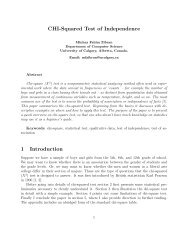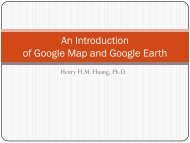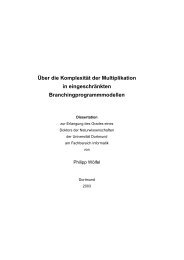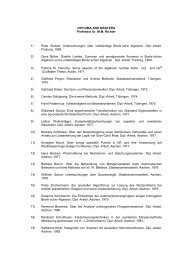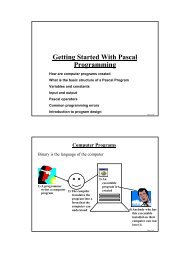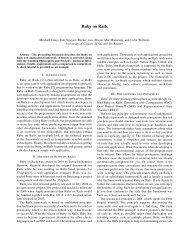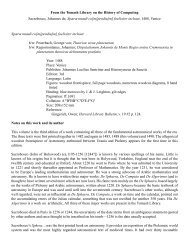Motion Swarms - University of Calgary
Motion Swarms - University of Calgary
Motion Swarms - University of Calgary
Create successful ePaper yourself
Turn your PDF publications into a flip-book with our unique Google optimized e-Paper software.
<strong>Motion</strong> <strong>Swarms</strong>: Video Interaction for<br />
Art in Complex Environments<br />
Quoc Nguyen, Scott Novakowski, Jeffrey E. Boyd, Christian Jacob ∗<br />
, Gerald Hushlak †<br />
Departments <strong>of</strong> Computer Science and Art<br />
<strong>University</strong> <strong>of</strong> <strong>Calgary</strong><br />
<strong>Calgary</strong>, Alberta, Canada T2N 1N4<br />
{nguyenq,scottn,boyd,jacob}@cpsc.ucalgary,ca, hushlak@ucalgary.ca<br />
ABSTRACT<br />
We create interactive art that can be enjoyed by groups such<br />
as audiences at public events with the intent to encourage<br />
communication with those around us as we play with the<br />
art. Video systems are an attractive mechanism to provide<br />
interaction with artwork. However, public spaces are complex<br />
environments for video analysis systems. Interaction<br />
becomes even more difficult when the art is viewed by large<br />
groups <strong>of</strong> people. We describe a video system for interaction<br />
with art in public spaces and with large audiences using a<br />
model-free, appearance-based approach. Our system extracts<br />
parameters that describe the field <strong>of</strong> motion seen by a camera,<br />
and then imposes structure on the scene by introducing<br />
a swarm <strong>of</strong> particles that moves in reaction to the motion<br />
field. Constraints placed on the particle movement impose<br />
further structure on the motion field. The artistic display<br />
reacts to the particles in a manner that is interesting and<br />
predictable for participants. We demonstrate our video interaction<br />
system with a series <strong>of</strong> interactive art installations<br />
tested with the assistance <strong>of</strong> a volunteer audience.<br />
Categories and Subject Descriptors<br />
J.5 [Computer Applications: Arts and Humanities]:<br />
Fine Arts; H.5.1 [Information Interfaces and Presentation]:<br />
Multimedia Information Systems–Animations,video;<br />
H.5.2 [Information Interfaces and Presentation]: User<br />
Interfaces–Input devices and strategies; I.4.8 [Image Processing<br />
and Computer Vision]: Scene Analysis–<strong>Motion</strong>,<br />
tracking<br />
General Terms<br />
Algorithms, Design, Experimentation, Human Factors<br />
∗<br />
Nguyen, Novakowski, Boyd and Jacob are in Department<br />
<strong>of</strong> Computer Science<br />
†<br />
Department <strong>of</strong> Art<br />
Permission to make digital or hard copies <strong>of</strong> all or part <strong>of</strong> this work for<br />
personal or classroom use is granted without fee provided that copies are<br />
not made or distributed for pr<strong>of</strong>it or commercial advantage and that copies<br />
bear this notice and the full citation on the first page. To copy otherwise, to<br />
republish, to post on servers or to redistribute to lists, requires prior specific<br />
permission and/or a fee.<br />
MM’06, October 23–27, 2006, Santa Barbara, California, USA.<br />
Copyright 2006 ACM 1-59593-447-2/06/0010 ...$5.00.<br />
461<br />
Keywords<br />
Audience interaction, swarm art, motion analysis, motion<br />
history image, interaction through video, art installation<br />
1. INTRODUCTION<br />
As “The new electronic interdependence recreates the<br />
world in the image <strong>of</strong> a global village” [20] people can find<br />
themselves isolated by new technologies. It seems that people<br />
prefer to talk to those that are elsewhere than to talk to<br />
the person standing to them. Vonnegut [25] suggests that<br />
“Electronic communities build nothing. ...We are here on<br />
earth to fart around.” In response, we fart around with<br />
technology to create interactive art that can be enjoyed by<br />
groups such as audiences at public events. This group interaction<br />
has the pleasant side effect <strong>of</strong> encouraging communication<br />
with those around us as we play with the art.<br />
Video systems are an attractive mechanism to enable interaction<br />
with art. They are inexpensive, easy to install,<br />
and impose few physical constraints. However, public spaces<br />
are complex environments for video analysis systems. The<br />
number <strong>of</strong> people seen by a camera can vary from none to<br />
many. There may be motion in the background. Light and<br />
weather conditions may vary. Clothing varies. For effective<br />
interaction, the video system must accommodate all <strong>of</strong> these<br />
factors.<br />
Interaction becomes even more difficult when the art is<br />
viewed by groups <strong>of</strong> people. Imagine spectators at a sports<br />
event watching an artistic display while interacting with and<br />
manipulating the display through their motion. In this scenario,<br />
video interaction faces all the confounding factors in<br />
any public space in addition to the scene complexity arising<br />
from the number <strong>of</strong> people interacting (and some people<br />
choosing not to interact). Figure 1 illustrates the complexity<br />
with an audience at an international speed skating event.<br />
The photographs show people clapping and banging objects<br />
to make noise, waving national flags, moving up and down<br />
stairs, and traversing the walkway behind the bleachers.<br />
In this paper we describe a video system for interaction<br />
with art in public spaces and with large audiences. Rather<br />
than attempting to extract detailed information about people,<br />
objects, and trajectories from the video input, we use<br />
a model-free, appearance-based approach. In doing so, our<br />
system extracts parameters that describe the field <strong>of</strong> motion<br />
presented to the system independent <strong>of</strong> any object-specific<br />
knowledge related to the scene. This yields a robust system
Figure 1: Examples <strong>of</strong> audience activity at an international<br />
speed skating event illustrating scene and<br />
motion complexity.<br />
that is immune to many <strong>of</strong> the factors that can confound<br />
video interaction. Although our model-free approach obviates<br />
the need for object-specific information, it must still<br />
impose some structure upon the motion field to avoid an apparently<br />
random reaction to complex motion. We get this<br />
structure by introducing a swarm <strong>of</strong> particles that moves in<br />
reaction to the underlying motion field. Constraints placed<br />
on the particle movement impose further structure on the<br />
motion field. The artistic display reacts to the agents in a<br />
manner that is interesting and predictable for participants.<br />
We demonstrate our video interaction system with artistic<br />
displays generated from swarms <strong>of</strong> autonomous agents<br />
inspired by Boyd et al. [7]. The combination <strong>of</strong> esthetic displays<br />
and our interaction system yields engaging interactive<br />
installations.<br />
Procedures for human-subject experiments and observations<br />
described in the paper were reviewed and approved by<br />
the ethics review board at the <strong>University</strong> <strong>of</strong> <strong>Calgary</strong>.<br />
2. BACKGROUND<br />
2.1 Large-Scale Audience Interaction<br />
Event organizers <strong>of</strong>ten try to incorporate the audience<br />
into their events. By engaging the audience, they give people<br />
a sense <strong>of</strong> participation, reinforcing the notion that the<br />
audience is important to the organizers. In many cases, the<br />
mood <strong>of</strong> the audience can determine the success <strong>of</strong> an event.<br />
Therefore, many event organizers devise methods to engage<br />
an audience to keep them happy and entertained.<br />
Many sporting events try to engage their audiences. For<br />
example, mascots interact with the audiences and influence<br />
them to cheer for a team. Video screens cue audiences to<br />
clap and make noise. To re-inforce the mood <strong>of</strong> the event,<br />
video footage <strong>of</strong> the excited audience is displayed on these<br />
screens. Television shows engage live audiences, such as the<br />
show “Who Wants to be a Millionaire”, where the audience<br />
can help a contestant through a voting system. Various<br />
universities entice students to participate during lectures by<br />
using the Classroom Performance System(CPS) [12].<br />
Audience motion and behavior is complex, making unconstrained<br />
audience interaction practically impossible. To<br />
make interaction succeed, it is necessary to constrain the<br />
interface in some way.<br />
462<br />
One option is to constrain interaction to a physical input<br />
device, e.g., a device with which a person can enter<br />
responses to stimuli. eInstruction [12] has developed such<br />
input devices for classroom environments to give a lecturer<br />
immediate feedback from the students. Scheible et al. [23]<br />
demonstrated audience interaction using a cell phone as a<br />
voting device to select music videos. Input devices are an<br />
effective way to receive audience input but there are certain<br />
constraints associated with these devices including distribution<br />
and price <strong>of</strong> the devices. The devices can be cumbersome<br />
or difficult to use, having a negative impact on the<br />
audience.<br />
Maynes-Aminzade et al. [19] devised a series <strong>of</strong> games to<br />
engage a large audience. Their primary method <strong>of</strong> interaction<br />
was through basic computer vision techniques with<br />
the aid <strong>of</strong> some simple props. In one example, the audience<br />
leans left or right to control a paddle in the video game<br />
Pong. In this case, constraining the allowable audience motion<br />
makes interaction possible. In another example, the<br />
audience throws a ball around. The ball casts a shadow<br />
onto a screen which was then tracked using computer vision<br />
techniques. The audience used the ball to control input<br />
to the Missile Command video game. The ball acts as a<br />
mechanism to reduce complexity and facilitate interaction.<br />
Breazeal et al. [8] devised a robot that responds to a small<br />
audience using computer vision techniques. Audiences viewing<br />
the robot compete for the attention <strong>of</strong> the robot using<br />
hand and face movements. The robot detects the movements<br />
<strong>of</strong> faces and hands using features extracted from images <strong>of</strong><br />
the audience. In this case, the interaction is constrained<br />
by having the robot follow simple motions and limiting the<br />
quality <strong>of</strong> interaction that is possible.<br />
In this paper, we advance the use <strong>of</strong> model-free computer<br />
vision techniques by imposing structure on the motion to<br />
reduce complexity and facilitate meaningful interaction.<br />
2.2 Model-Free Vision<br />
Historically, computer vision research in human motion<br />
analysis can be divided into two broad categories: modelbased<br />
and model-free. The model is kinematic, describing<br />
the interconnected parts that make up the human body and<br />
their kinetic relationship to each other. Model-free methods<br />
are sometimes referred to as appearance-based. Much <strong>of</strong> the<br />
vision research on human motion is focused on either recognizing<br />
some activity or action, or recognizing an individual<br />
as in biometric gait recognition.<br />
In the model-free category Little and Boyd [17] describe<br />
a shape-<strong>of</strong>-motion system that analyzes periodicities in the<br />
shapes <strong>of</strong> people as they walk. Baumberg and Hogg [2, 3]<br />
describe the shape <strong>of</strong> the silhouette <strong>of</strong> walkers. Bobick and<br />
Davis [4, 5] accumulate motion information into a motion<br />
energy image and a motion history image to recognize human<br />
activities. Boyd [6], Liu and Picard [18], and Polana<br />
and Nelson [21] look at oscillations in image intensities due<br />
to gait in order to analyze gaits. Cutler and Davis [10] describe<br />
a system that identifies periodicities in the motion <strong>of</strong><br />
objects in order to identify human and animal gaits. Haritaoglu<br />
et al. [14] describe a system that classifies a silhouette<br />
<strong>of</strong> a human into one <strong>of</strong> four main postures, and then further<br />
classify it into one <strong>of</strong> three view-based appearances.<br />
In the model-based category Hunter et al. [15], Rowley<br />
and Rehg [22], and Bregler and Malik [9] use models that<br />
represent joints and limbs in a human. They estimate the
kinematic pose <strong>of</strong> a person by extracting joint angle information<br />
from a sequence <strong>of</strong> images. Wachter and Nagel [26]<br />
describe a system that derives pose by tracking individual<br />
body parts using constraints imposed by the known kinematic<br />
structure. While these approaches use an explicit<br />
kinematic model, the model need not be so detailed. Wren et<br />
al. [27] track a set <strong>of</strong> blobs that are parts <strong>of</strong> a person. Their<br />
system identifies some body parts based on their expected<br />
locations in typical views. They do not strictly enforce a<br />
kinematic model. Fujiyoshi and Lipton [13] use a simplified<br />
model <strong>of</strong> a person that maps a star skeleton onto the<br />
silhouette <strong>of</strong> a moving person.<br />
Also within the model-based category are motion capture<br />
systems. These systems, pioneered by Johansson [16], typically<br />
use markers placed on the limbs <strong>of</strong> the subject that are<br />
then tracked. Johansson originally used marker motion as<br />
a stimulus in psychological experiments, but currently, the<br />
most common use is to recover the kinematic pose <strong>of</strong> the<br />
subject for applications in computer games, graphics and<br />
research in kinesiology.<br />
While marker-based motion capture is the most precise<br />
method, it is the least practical for interaction with art due<br />
to the need for markers on the participants. Other modelbased<br />
methods eliminate the need for markers, but still require<br />
strict control over imaging conditions that eliminate<br />
the possibility for interaction in a complex environment.<br />
Furthermore, recovering kinematic pose for many people in<br />
an audience simultaneously is not practical.<br />
Model-free methods provide the most likely method to<br />
allow an audience to interact with art. However, existing<br />
methods focus on the actions <strong>of</strong> a single person or a small<br />
group. <strong>Motion</strong> patterns become more complex as the number<br />
<strong>of</strong> people increases. To use model-free methods for interaction<br />
requires further refinement.<br />
3. MOTION SWARMS<br />
<strong>Motion</strong> history images [4, 5] (MHI) provide a representation<br />
<strong>of</strong> a field <strong>of</strong> motion that is independent <strong>of</strong> the number <strong>of</strong><br />
people or scene complexity. However, for useful interaction,<br />
it is necessary to find some order in the motion field. Bobick<br />
and Davis [4, 5] do this by characterizing the shape generated<br />
by a single person in the field with a set <strong>of</strong> moments.<br />
This approach is prohibitive for a large group <strong>of</strong> people since<br />
no small set <strong>of</strong> moments can capture the richness and complexity<br />
<strong>of</strong> group activities.<br />
We introduce the concept <strong>of</strong> a motion swarm, aswarm<strong>of</strong><br />
particles that moves in response to the field representing a<br />
motion history image. Structure imposed on the behavior <strong>of</strong><br />
the swarm forces a response to the motion history images.<br />
To create interactive art, the art responds to the motion<br />
swarm and not the motion directly. The appearance <strong>of</strong> the<br />
swarm gives structure to the interaction so the art responds<br />
to the audience in a meaningful way and does not appear to<br />
be random.<br />
3.1 <strong>Motion</strong> Intensity Field<br />
Pixels in an MHI indicate how recently a pixel has changed<br />
in intensity. Brighter pixels have changed more recently<br />
while darker pixels have not changed. Changes in intensity<br />
are presumed to be due to motion.<br />
Let Tk(x) be a binary image that indicates whether or<br />
not the pixel at x =[x, y] T changed significantly in video<br />
frame k. We can compute Tk using adaptive background<br />
463<br />
subtraction as follows:<br />
j<br />
1 |Ik(x) −<br />
Tk(x) =<br />
Ĩk(x)| ≥τ<br />
0 otherwise<br />
where Ik is the image at time k, Ĩk is I smoothed in time,<br />
and τ is a threshold that determines what intensity change<br />
is significant. The temporal smoothing <strong>of</strong> I over a wide time<br />
window allows the background to adapt to slow changes in<br />
scene illumination. A recursive, infinite impulse response<br />
(IIR) filter allows for computationally efficient smoothing<br />
over broad temporal windows.<br />
The MHI at time k is given by<br />
Mk(x) =max(cTk(x),Mk−1(x) − 1).<br />
Note that cTk(x) ∈{0,c}. Thus, when a pixel changes, the<br />
corresponding pixel in the MHI is set to c, otherwise,the<br />
value is decremented, never going below zero. The constant,<br />
c sets the persistence <strong>of</strong> the motion history.<br />
Since we desire to have swarm particles respond in a natural<br />
and predictable manner, we smooth Mk(x) inspaceto<br />
get<br />
˜Mk(x) =Mk(x) ⊗ G(x; σ),<br />
where ⊗ indicates convolution and G is a Gaussian kernel.<br />
This also broadens the basin <strong>of</strong> attraction for particles described<br />
in Section 3.2. In our application we select σ large,<br />
and a recursive filter [11] provides a computationally efficient<br />
implementation for arbitrary values <strong>of</strong> σ.<br />
3.2 Particles<br />
In public places and large audiences, the motion field is<br />
complex. To extract some structure from the field, we introduce<br />
swarms <strong>of</strong> particles that move in response to the MHI<br />
by treating the MHI as a field. The gradient <strong>of</strong> the MHI<br />
yields forces that act on the particles. We then introduce<br />
other forces such as friction and neighborhood interactions.<br />
Simulation <strong>of</strong> the forces acting on the particle leads to the<br />
particle motion that forms the basis for interaction.<br />
Let xk = [x, y] T be the position <strong>of</strong> a particle, vk =<br />
[vx,vy] T be its velocity, and pk =[px,py] T be its momentum<br />
at time interval k. Δt is the time sample interval. The<br />
following equations (used in physics simulations and video<br />
games) simulate particle movement in response to a force F<br />
acting on it:<br />
xk = xk−1 + vk−1Δt, (1)<br />
pk = pk−1 + Fk(x)Δt, and (2)<br />
vk = pk<br />
, (3)<br />
m<br />
where m is the particle mass. In the context <strong>of</strong> our system<br />
where particles are imaginary points with no mass, m is a<br />
tunable constant.<br />
For a particle at position x, the force due to the motion<br />
field is<br />
FMk = ∇ ˜ Mk(x) ≈ 1<br />
»<br />
˜Mk([x +1,y]<br />
2<br />
T ) − ˜ Mk([x − 1,y] T )<br />
˜Mk([x, y +1] T ) − ˜ Mk([x, y − 1] T –<br />
)<br />
(4)<br />
If we let F = FMk , then the particles will tend to move up<br />
the gradient <strong>of</strong> the MHI. Since the brightest pixels in the<br />
MHI are where motion has most recently occurred, the particles<br />
tend to follow the motion. Alternatively, the motion<br />
can repel the particles by either setting m
Figure 2: Example showing motion particle generation. The top row shows a sequence <strong>of</strong> images with a<br />
hand moving upward. The bottom row shows the corresponding motion fields (smoothed MHI) with a single<br />
particle following the motion superimposed.<br />
F = −FMk . Figure 2 illustrates the MHI and motion particles<br />
with an example.<br />
3.3 Additional Structure<br />
The introduction <strong>of</strong> moving particles to the motion field<br />
adds structure to the representation <strong>of</strong> the motion by sampling<br />
at a fixed number <strong>of</strong> points (the particle positions) and<br />
by forcing the particles to react to the motion field. Further<br />
constraints to the particle motion add more structure to the<br />
particle representation.<br />
Additional constraints that we use in our work include:<br />
• Friction: Frictional forces act in opposition to particle<br />
velocity. Without friction, the particles continue<br />
to accelerate, getting faster every time they encounter<br />
motion. Friction allows the particles to slow down in<br />
the absence <strong>of</strong> motion, and can prevent particles from<br />
shooting past regions <strong>of</strong> motion because their velocity<br />
is too high.<br />
• Momentum Limits: Particles that move fast are not<br />
conducive to interaction. People cannot keep up with<br />
them. Therefore, we place an upper and lower bound<br />
on the magnitude <strong>of</strong> the particle momentum. The upper<br />
bound prevents the particle from moving too fast,<br />
and the lower bound prevents the particle from coming<br />
to a complete stop.<br />
• Bounding Box: It is useful to constrain the particles<br />
to move only with a defined bounding box. At the<br />
very least, a bounding box the size <strong>of</strong> the images is<br />
necessary to keep the particles from going beyond the<br />
image boundaries. However, bounding boxes can also<br />
be useful to define sub-images <strong>of</strong> interest. For example,<br />
in an interactive game between two groups <strong>of</strong> people,<br />
we can define a bounding box for the image region<br />
corresponding to each group.<br />
• Anchors: We can anchor a particle by defining a central<br />
position and adding a force that propels the particle<br />
toward that position. This is useful when we want<br />
to maintain a distribution <strong>of</strong> points throughout the<br />
image space. Without the anchors, the particles can<br />
464<br />
simultaneously follow motion to one part <strong>of</strong> the image<br />
and leave large portions <strong>of</strong> the image unsampled, and<br />
therefore unavailable for interaction. We model the anchoring<br />
force as a spring between the center position<br />
and the particle.<br />
Each <strong>of</strong> these parameters introduces tunable parameters<br />
to the system. Tuning the parameters alters the behavior<br />
<strong>of</strong> the particles significantly and alters the nature <strong>of</strong> the<br />
interaction. We demonstrate a number <strong>of</strong> different behaviors<br />
achieved by tuning parameters in the exhibits described in<br />
Section 5.<br />
4. BUILDING ART INSTALLATIONS<br />
Our interactive art installations consist <strong>of</strong> two basic components:<br />
1. Video Processing: Video processing acquires the<br />
images, computes the MHI, smoothes the MHI to get<br />
a motion field, and does particle simulations.<br />
2. Artistic Display: The artistic display produces the<br />
images that viewers <strong>of</strong> the installation actually see.<br />
This section describes our implementation <strong>of</strong> these components.<br />
4.1 Video Processing<br />
We do all video processing on a dedicated system acting<br />
as a server. We code in Python, relying on C- and<br />
assembly-based libraries to do the fast inner-loop computations<br />
required for the video. The server communicates via<br />
network, exchanging XML documents and image data via<br />
HTTP protocol. We configure the server and tune particle<br />
parameters by sending XML documents to the server. The<br />
server broadcasts source video, MHI, and XML documents<br />
containing the particle positions.<br />
4.2 Artistic Display<br />
The artistic display communicates with the video server<br />
to acquire images and particle positions. It then does simulation<br />
and rendering to produce an esthetically pleasing
Figure 3: Photograph <strong>of</strong> the trial in progress. The<br />
audience views the projected display from seats in<br />
a large lecture theater. A camera beside the projection<br />
screen views the audience providing input to<br />
the artistic display.<br />
display. We use either Breve [24] or Quartz Composer [1]<br />
for simulation and rendering.<br />
Breve is a swarm simulation system with excellent capabilities<br />
for rendering swarms for visualization. Our use <strong>of</strong><br />
motion swarms for interaction is a natural match for Breve.<br />
We added modules to Breve to allow it to interact with the<br />
video processing system and read XML documents. In addition<br />
to its rendering capabilities, Breve also facilitates production<br />
<strong>of</strong> sound, which we exploit in one <strong>of</strong> the installations<br />
describedinSection5.<br />
Quartz Composer is a high-level development system used<br />
for generating three-dimensional images. The graphical language<br />
used to program in Quartz Composer allows us to<br />
quickly generate impressive three-dimensional rendering. We<br />
use this extensively in the installations described in Section<br />
5.<br />
5. AUDIENCE TRIALS<br />
Live audiences suitable for testing interactive art are not<br />
easy to come by. Organizers responsible for events that draw<br />
a large audience are reluctant to allow an untried installation<br />
to become part <strong>of</strong> their event. Conversely, without an<br />
audience, we cannot test the installation to acquire the evidence<br />
necessary. Thus, to demonstrate our installations, we<br />
are restricted to working with an artificially assembled audience.<br />
In our case, we assembled a group <strong>of</strong> approximately<br />
25 volunteers to participate as a makeshift audience in a<br />
university lecture theater. We placed a video camera at the<br />
front <strong>of</strong> the room and pointed it towards the audience, and<br />
then used the available projection equipment to display the<br />
renderings for all to see (see Figure 3). Participants were encouraged<br />
to move as they desired, but no instruction on how<br />
to interact were given. We provided cardboard squares the<br />
participants could wave to produce motion for the cameras.<br />
This was particularly useful for those at the back whose images<br />
would otherwise have been quite small in the camera<br />
due to foreshortening.<br />
We recorded images <strong>of</strong> the rendered display and <strong>of</strong> the audience<br />
directly. Lighting was challenging. We wanted dark-<br />
465<br />
Figure 4: Interactive music with motion swarm interaction.<br />
Participant movement propels the balls.<br />
Thebluebandatthetop<strong>of</strong>theimageemulatesa<br />
keyboard that plays music when struck by the balls.<br />
ness to enhance the projected display, but also wanted light<br />
so that the camera could see the motion. The compromise<br />
we found was to use the Night Shot feature on the camera<br />
which removes the infrared filter in the camera and provides<br />
some infrared illumination to compensate for dimmed lights.<br />
While this was effective, it does result in washed-out images<br />
devoid <strong>of</strong> color, as can be seen in the examples that follow.<br />
As liquid crystal and plasma displays grow in size (and our<br />
budget too) we can move to alternate display technologies<br />
that are better for simultaneous video interaction and display.<br />
The remainder <strong>of</strong> this section describes four installations<br />
we tested with our makeshift audience and our observations.<br />
5.1 Music<br />
The first trial installation gets the mundane yet descriptive<br />
label, Music since it allows audience to produce music.<br />
Simulation, rendering, and sound generation for Music was<br />
done using Breve. Figure 4 shows a photograph <strong>of</strong> the rendered<br />
display.<br />
The audience sees an image <strong>of</strong> themselves, reversed leftto-right<br />
to give the effect <strong>of</strong> a mirror. Superimposed upon<br />
the image is a blue band at the top <strong>of</strong> the image and a set <strong>of</strong><br />
green balls. The ball positions correspond to the positions<br />
<strong>of</strong> particles simulated by the video system. Parameters are<br />
tuned so that motion repels the particles/balls. As the audience<br />
waves hands and swats at the balls, they propel them<br />
around the display. The blue band at the top <strong>of</strong> the image<br />
behaves as a virtual keyboard. When a ball hits the<br />
blue band, the keyboard plays music and the audience is<br />
rewarded with the sounds they generate.<br />
Observations: Although the audience received no instructions,<br />
they were quick to grasp the mode <strong>of</strong> interaction<br />
(Figure 5(a)). In a few seconds, the audience was swatting<br />
at balls and producing music. The music they produce, although<br />
not strictly random and constrained to play on a<br />
natural scale, was not sophisticated enough to sustain interest<br />
after a three or four minutes <strong>of</strong> play. The number <strong>of</strong><br />
balls in the display was not conducive to team play. People<br />
merely swatted at whatever ball was closest. There was no
Figure 7: Photograph <strong>of</strong> hockey installation where<br />
team logos move with the motion swarm particles.<br />
Logos <strong>of</strong> opposing teams appear on opposite sides<br />
<strong>of</strong> the screen while participants compete to move<br />
the logos <strong>of</strong> their team. The logo particles are constrained<br />
to return to a home position.<br />
need to cooperate since no matter what one did, another<br />
ball was sure to come by in a moment.<br />
5.2 Volleyball<br />
We labeled our second trial installation Volleyball because<br />
the interaction allowed the audience to move a ball back and<br />
forth as in a volleyball game. Simulation and rendering were<br />
done using Quartz Composer. A series <strong>of</strong> images showing<br />
this installation in action is in Figure 6.<br />
Again, the audience sees a mirror image <strong>of</strong> themselves on<br />
the display. Superimposed on the display is a single ball. In<br />
this case, the ball is attracted to motion. As the ball moves,<br />
the audience sees that their image is rendered on a surface<br />
that moves with the ball. In fact, the displayed position<br />
<strong>of</strong> the ball never changes. Only the image <strong>of</strong> the audience<br />
moves. A tail flowing behind the ball emphasizes the ball’s<br />
motion.<br />
Observations: Initially the audience has trouble interacting<br />
(Figure 5(b)). This may be because <strong>of</strong> the preceding<br />
trial where their motion repelled balls propelling them<br />
around the display. Now when a person moves near the ball,<br />
the ball moves to them and is stuck there until they stop<br />
moving. This difficulty does not last long and the audience<br />
eventually starts to pass the ball around the room. It is difficult<br />
because the participants must coordinate their motion,<br />
first moving to attract the ball, then stopping to allow the<br />
ball to move on, all synchronized among the group. This was<br />
our most successful trial with respect to team work. A single<br />
ball and the need to coordinate group motion encouraged<br />
cooperation and interaction among audience participants.<br />
5.3 Hockey<br />
Our third trial we labeled Hockey due to the use <strong>of</strong> pr<strong>of</strong>essional<br />
hockey team logos in the display. Simulation and<br />
rendering were done by Quartz Composer. Figure 7 shows<br />
a photograph <strong>of</strong> this installation in action.<br />
The audience sees a display with the names <strong>of</strong> rival hockey<br />
teams, one above each side <strong>of</strong> the display. Six copies <strong>of</strong> each<br />
team logo appear below their team name. As the audience<br />
466<br />
Figure 8: Photographs <strong>of</strong> the Spray Paint installation.<br />
Images <strong>of</strong> the audience are digitally sprayed<br />
onto the display at the locations <strong>of</strong> motion swarm<br />
particles.<br />
moves, the logos are attracted by the motion causing the<br />
logos to move. As the logos move, they create a brilliantly<br />
colored tail and the team name begins to pulse. The audience<br />
is able to engage in a sort <strong>of</strong> competition to get their<br />
team name and logo to be the most animated. Each logo<br />
corresponds to a motion particle. The particle motion is<br />
constrained to remain in its side <strong>of</strong> the image by a bounding<br />
box. Also, the logos are anchored to maintain coverage <strong>of</strong><br />
the audience.<br />
Observations: The goal is simple and the audience grasps<br />
it quickly, working to create motion and keep the logos moving<br />
(Figure 5(c)). No coordinated behavior is required, but a<br />
rivalry between the two sides quickly emerges. The interaction<br />
is fun, but the high energy output required to maintain<br />
the motion exhausts enthusiasm after one to two minutes.<br />
5.4 Spray Paint<br />
Our fourth, and final installation we call Spray Paint.<br />
Simulation and rendering are done in Breve. Figure 8 shows<br />
photographs <strong>of</strong> the installation.<br />
The audience sees an image with a set <strong>of</strong> three balls superimposed.<br />
The balls follow the positions <strong>of</strong> motion particles,<br />
acting as virtual spray cans, spray painting the image <strong>of</strong> the<br />
audience onto the display. Where the balls are present, we
(a) (b)<br />
(c) (d)<br />
Figure 5: Photographs <strong>of</strong> audience interaction with (a) Music, (b)Volleyball, (c)Hockey, and(d)Spray Paint.<br />
Figure 6: Sequence showing interaction with volley ball exhibit (order is left to right, top to bottom).<br />
Participants manipulate a single ball that is attracted to motion. The display warps the image <strong>of</strong> the audience<br />
so that the ball remains at the center <strong>of</strong> the display. Participants can co-operate to move the ball around the<br />
audience.<br />
467
see moving video rendered with a spray-paint effect. Where<br />
the balls are absent, the image is frozen as it appeared when<br />
last sprayed.<br />
Observations: When the audience was seated, this installation<br />
proved less interesting than the first three. However,<br />
when the audience begins to move around the room,<br />
the spray-painting effect comes to life (Figure 5(d)). As<br />
people walk in front <strong>of</strong> the camera, across rows in the lecture<br />
theater, and up and down the stairs, they produced<br />
intriguing images and engage in play with the installation.<br />
The temporal effects where some <strong>of</strong> the display is moving<br />
and other parts are frozen was particularly fun as people<br />
tried to control the motion to steer the balls and update the<br />
image.<br />
6. DISCUSSION AND CONCLUSIONS<br />
Public spaces and audiences are complex environments<br />
for video interaction. Meaningful interaction is only possible<br />
by constraining interaction to fewer, simpler entities.<br />
We demonstrated a video interaction system for art installations<br />
that resolves the complexity by first analyzing the<br />
motion with model-free vision techniques, then modeling a<br />
swarm <strong>of</strong> particles to impose some structure on the motion.<br />
The system is versatile in that it is tolerant <strong>of</strong> a variety <strong>of</strong><br />
imaging conditions and will produce meaningful interaction<br />
in arbitrarily complex situations.<br />
Our model-free appearance-based approach faces a dilemma<br />
in interactive art. In our society, we have become accustomed<br />
to computer interaction with the precision afforded<br />
by a mouse. In order to accommodate complex scenes, we<br />
abandon this precision in favor <strong>of</strong> a method that is robust<br />
and versatile. Although our volunteer audience had fun<br />
with our installations, we sense that they craved to point<br />
and click. We are inclined to resist this craving so that our<br />
installations can take people away from their routine interactions<br />
with technology into another realm that is perhaps<br />
more fun.<br />
We did not ignore esthetics in our installations, but we certainly<br />
have not explored the esthetic potential <strong>of</strong> our video<br />
interaction/display medium. Our translation from motion<br />
particles to visual entities in the display was direct and literal.<br />
There is definitely space to play in the esthetic dimension<br />
to find even more varied and interesting displays.<br />
7. REFERENCES<br />
[1] Apple Computer Inc. Working with quartz composer.<br />
Retrieved May 30, 2006, from<br />
http://developer.apple.com/graphicsimaging/quartz/quartzcomposer.html,<br />
2005.<br />
[2] A. M. Baumberg and D. C. Hogg. Learning flexible<br />
models from image sequences. Technical Report 93.36,<br />
<strong>University</strong> <strong>of</strong> Leeds School <strong>of</strong> Computer Studies,<br />
October 1993.<br />
[3] A. M. Baumberg and D. C. Hogg. Learning<br />
spatiotemporal models from training examples. In<br />
British Machine Vision Conference, Birmingham,<br />
September 1995.<br />
[4] A. F. Bobick and J. W. Davis. An appearance-based<br />
representation <strong>of</strong> action. In 13th International<br />
Conference on Pattern Recognition, Vienna, Austria,<br />
August 1996.<br />
468<br />
[5] A. F. Bobick and J. W. Davis. Real-time recognition<br />
<strong>of</strong> activity using temporal templates. In Third<br />
International Workshop on Applications <strong>of</strong> Computer<br />
Vision, Sarasota, Florida, December 1996.<br />
[6] J. E. Boyd. Video phase-locked loops in gait<br />
recognition. In International Conference on Computer<br />
Vision, pages 696–703, Vancouver, BC, 2001.<br />
[7] J. E. Boyd, C. Jacob, and G. Hushlak. Swarmart:<br />
interactive art from swarm intelligence. In ACM<br />
Multimedia 04, pages 628–635, New York, NY,<br />
October 2004.<br />
[8] C. Breazeal, A. Brooks, J. Gray, M. Hancher,<br />
J. McBean, D. Stiehl, and J. Strickon. Interactive<br />
robot theatre. Commun. ACM, 46(7):76–85, 2003.<br />
[9] C. Bregler and J. Malik. Tracking people with twists<br />
and exponential maps. In Computer Vision and<br />
Pattern Recognition 1998, Santa Barbara, June 1998.<br />
[10] R. Cutler and L. Davis. Robust periodic motion and<br />
motion symmetry detection. In Computer Vision and<br />
Pattern Recognition 2000, 2000.<br />
[11] R. Deriche. Fast algorithms for low-level vision. IEEE<br />
Transactions on Pattern Analysis and Machine<br />
Intelligence, 12(1):78–87, 1990.<br />
[12] eInstruction. Classroom performance system.<br />
Retrieved May 30, 2006, from<br />
http://www.einstruction.com/.<br />
[13] H. Fujiyoshi and A. J. Lipton. Real-time human<br />
motion analysis by image skeletonization. In DARPA<br />
Image Understanding Workshop, Monterey, California,<br />
November 1998.<br />
[14] I. Haritaoglu, D. Harwood, and L. S. Davis. Ghost: a<br />
human body part labelling system using silhouettes.<br />
In DARPA Image Understanding Workshop, pages<br />
229–235, Monterey, California, November 1998.<br />
[15] E. A. Hunter, P. H. Kelly, and R. C. Jain. Estimation<br />
<strong>of</strong> articulated motion using kinematically constrained<br />
mixture densities. In Nonrigid and Articulated <strong>Motion</strong><br />
Workshop, San Juan, Peurto Rico, June 1997.<br />
[16] G. Johansson. Visual motion perception. Scientific<br />
American, pages 76–88, June 1975.<br />
[17] J. J. Little and J. E. Boyd. Recognizing people by<br />
their gait: the shape <strong>of</strong> motion. Videre, 1(2):1–32,<br />
1998.<br />
[18] F. Liu and R. W. Picard. Finding periodicity in space<br />
and time. In International Conference on Computer<br />
Vision, 1998.<br />
[19] D. Maynes-Aminzade, R. Pausch, and S. Seitz.<br />
Techniques for interactive audience participation. In<br />
ICMI ’02: Proceedings <strong>of</strong> the 4th IEEE International<br />
Conference on Multimodal Interfaces, page 15,<br />
Washington, DC, USA, 2002. IEEE Computer Society.<br />
[20] M. McLuhan and Q. Fiore. The Medium is the<br />
Message. Bantam Books/Random House, 1967.<br />
[21] R. Polana and R. Nelson. Detection and recognition <strong>of</strong><br />
periodic, nonrigid motion. International Journal <strong>of</strong><br />
Computer Vision, 23(3):261–282, June 1997.<br />
[22] H. A. Rowley and J. M. Rehg. Analyzing articulated<br />
motion using expectation-maximization. In Computer<br />
Vision and Pattern Recognition 97, pages 935–941,<br />
San Juan, Peurto Rico, June 1997.
[23] J. Scheible and T. Ojala. Mobilenin - Combining a<br />
multi-track music video, personal mobile phones and a<br />
public display into multi-user interactive<br />
entertainment. In MULTIMEDIA ’05: Proceedings <strong>of</strong><br />
the 13th annual ACM international conference on<br />
Multimedia, pages 199–208, New York, NY, USA,<br />
2005. ACM Press.<br />
[24] L. Spector, J. Klein, C. Perry, and M. Feinstein.<br />
Emergence <strong>of</strong> collective behavior in evolving<br />
populations <strong>of</strong> flying agents. In E. C.-P. e. al., editor,<br />
Genetic and Evolutionary Computation Conference<br />
(GECCO-2003), pages 61–73, Chicago, IL, 2003.<br />
Springer-Verlag.<br />
469<br />
[25] K. Vonnegut. A Man Without a Country. Seven<br />
Stories Press, 2005.<br />
[26] S. Wachter and H.-H. Nagel. Tracking <strong>of</strong> persons in<br />
monocular image sequences. In Nonrigid and<br />
Articulated <strong>Motion</strong> Workshop, San Juan, Peurto Rico,<br />
June 1997.<br />
[27] C. Wren, A. Azarbayenjani, T. Darrell, and A. P.<br />
Pentland. Pfinder: real-time tracking <strong>of</strong> the human<br />
body. IEEE Transactions on Pattern Analysis and<br />
Machine Intelligence, 19(7):780–785, July 1997.



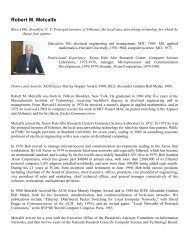
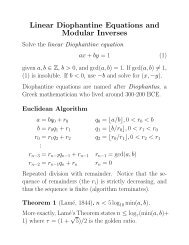

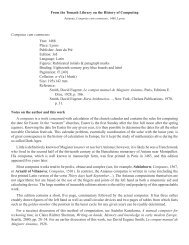
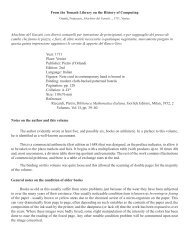
![Alfontii regis castelle illustrissimi celestiu[m]](https://img.yumpu.com/15135040/1/190x245/alfontii-regis-castelle-illustrissimi-celestium.jpg?quality=85)
